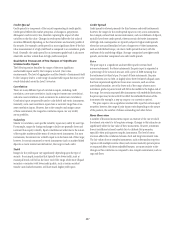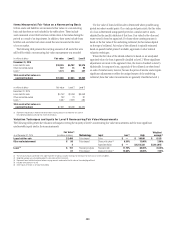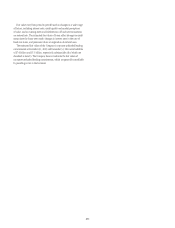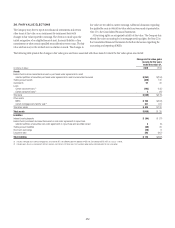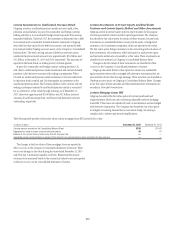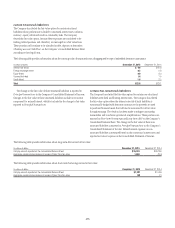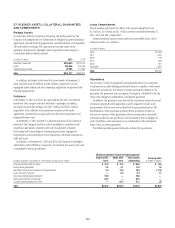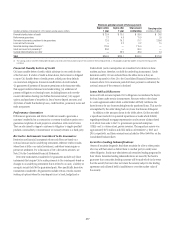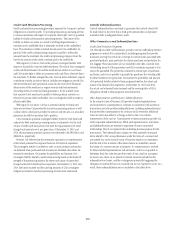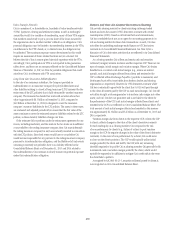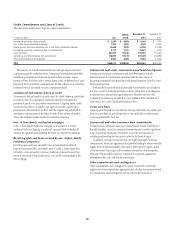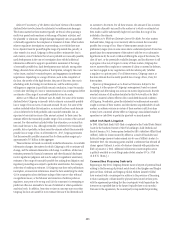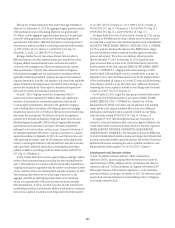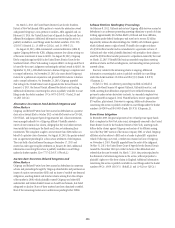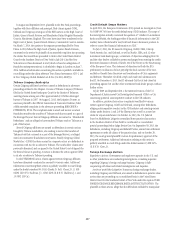Citibank 2015 Annual Report Download - page 295
Download and view the complete annual report
Please find page 295 of the 2015 Citibank annual report below. You can navigate through the pages in the report by either clicking on the pages listed below, or by using the keyword search tool below to find specific information within the annual report.
277
Maximum potential amount of future payments
In billions of dollars at December 31, 2014 except carrying value in millions
Expire within
1 year
Expire after
1 year
Total amount
outstanding Carrying value
(in millions of dollars)
Financial standby letters of credit $ 25.4 $ 73.0 $ 98.4 $ 242
Performance guarantees 7.1 4.8 11.9 29
Derivative instruments considered to be guarantees 12.5 79.2 91.7 2,806
Loans sold with recourse — 0.2 0.2 15
Securities lending indemnifications (1) 115.9 — 115.9 —
Credit card merchant processing (1) 86.0 — 86.0 —
Custody indemnifications and other — 48.9 48.9 54
Total $246.9 $206.1 $453.0 $ 3,146
(1) The carrying values of securities lending indemnifications and credit card merchant processing were not material for either period presented, as the probability of potential liabilities arising from these guarantees
is minimal.
Financial Standby Letters of Credit
Citi issues standby letters of credit, which substitute its own credit for that
of the borrower. If a letter of credit is drawn down, the borrower is obligated
to repay Citi. Standby letters of credit protect a third party from defaults
on contractual obligations. Financial standby letters of credit include
(i) guarantees of payment of insurance premiums and reinsurance risks
that support industrial revenue bond underwriting; (ii) settlement of
payment obligations to clearing houses, including futures and over-the-
counter derivatives clearing (see further discussion below); (iii) support
options and purchases of securities in lieu of escrow deposit accounts; and
(iv) letters of credit that backstop loans, credit facilities, promissory notes and
trade acceptances.
Performance Guarantees
Performance guarantees and letters of credit are issued to guarantee a
customer’s tender bid on a construction or systems-installation project or to
guarantee completion of such projects in accordance with contract terms.
They are also issued to support a customer’s obligation to supply specified
products, commodities, or maintenance or warranty services to a third party.
Derivative Instruments Considered to Be Guarantees
Derivatives are financial instruments whose cash flows are based on a
notional amount and an underlying instrument, reference credit or index,
where there is little or no initial investment, and whose terms require or
permit net settlement. For a discussion of Citi’s derivatives activities, see
Note 23 to the Consolidated Financial Statements.
Derivative instruments considered to be guarantees include only those
instruments that require Citi to make payments to the counterparty based on
changes in an underlying instrument that is related to an asset, a liability or
an equity security held by the guaranteed party. More specifically, derivative
instruments considered to be guarantees include certain over-the-counter
written put options where the counterparty is not a bank, hedge fund or
broker-dealer (such counterparties are considered to be dealers in these
markets and may, therefore, not hold the underlying instruments). Credit
derivatives sold by Citi are excluded from the tables above as they are
disclosed separately in Note 23 to the Consolidated Financial Statements. In
instances where Citi’s maximum potential future payment is unlimited, the
notional amount of the contract is disclosed.
Loans Sold with Recourse
Loans sold with recourse represent Citi’s obligations to reimburse the buyers
for loan losses under certain circumstances. Recourse refers to the clause
in a sales agreement under which a seller/lender will fully reimburse the
buyer/investor for any losses resulting from the purchased loans. This may be
accomplished by the seller taking back any loans that become delinquent.
In addition to the amounts shown in the tables above, Citi has recorded
a repurchase reserve for its potential repurchases or make-whole liability
regarding residential mortgage representation and warranty claims related
to its whole loan sales to the U.S. government-sponsored enterprises
(GSEs) and, to a lesser extent, private investors. The repurchase reserve was
approximately $152 million and $224 million at December 31, 2015 and
2014, respectively, and these amounts are included in Other liabilities on the
Consolidated Balance Sheet.
Securities Lending Indemnifications
Owners of securities frequently lend those securities for a fee to other parties
who may sell them short or deliver them to another party to satisfy some
other obligation. Banks may administer such securities lending programs for
their clients. Securities lending indemnifications are issued by the bank to
guarantee that a securities lending customer will be made whole in the event
that the security borrower does not return the security subject to the lending
agreement and collateral held is insufficient to cover the market value of
the security.


